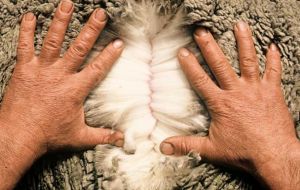MercoPress. South Atlantic News Agency
Falkland Island farmers tour Australia for improved sheep genetics
 Per annum FLH produces approximately 500,000 kilograms of greasy wool, from a Polwarth/Merino-type sheep. The fibre diameter averages 24-25 microns.
Per annum FLH produces approximately 500,000 kilograms of greasy wool, from a Polwarth/Merino-type sheep. The fibre diameter averages 24-25 microns. Three Falkland Islands farmers and the general manager of Falklands Landholdings Corporation recently travelled to Australia as part of the ongoing search for improvements to lamb survival rates in the Falklands. Touring farms in both Queensland and New South Wales, the group spent three weeks inspecting Australian studs in search of better fat and muscle values in young rams.
As part of the ongoing program to improve lamb survival rates in the Falkland Islands, a team of Falklands Landholdings Corporation (FLH) farm managers and the general manager of FLH recently travelled to Australia to undertake a three week tour of Australian Stud flocks. The aim of the trip was to continue the work done over the past decade in improving lamb survival rates, with a renewed focus on identifying young poll sires with high fat and muscle values.
The group, which was made up of three FLH farm managers (Keith Alazia, Gilberto Castro and Steven Dickson) and FLH General Manager Andy Pollard, travelled throughout Australia visiting a number of stud flocks, including Karbullah, Centre Plus and Trigger Vale. The group also visited Mumblebone Merino where former FLH General Manager, Neil Judd, travelled to last year and discovered poll sires with high fat and muscle values.
FLH confirmed the main purpose of their most recent visit was to “visit the merino studs that have supplied sheep genetics to the Islands” over the past ten years. In addition to visiting these studs, the tour also include visits to local farms, an abattoir, a wool processing factory, and a number of sheep and wool shows, including the Royal Adelaide Show and the World Merino Insight Conference.
Speaking about why introducing certain genetics from Australian poll Merino studs to the Falkland’s was being sought; FLH confirmed the hope is to “improve hardiness and robustness through positive genetic fat and eye muscle on a plain bodied, mid-micron polled Merino sheep”.
Whilst there is a high conception rate in Falklands, the lambing percentages are much lower at around 60%, with considerable losses occurring mainly due to harsh weather conditions and lambs not gaining the necessary body weight conditions quickly enough to survive. Statistics released earlier this year showed the lamb-marking percentage across the whole of the Falklands was 59.2%, with the highest percentages being achieved on the outer islands of 62.9%.
FLH farms – which manage around 145,000 sheep – recorded a slightly higher lambing rate than the overall average with 65%, with a total of just over 37,000 lambs marked during the 2015-2016 season.
Historically, FLH have focussed on improving fleece weights and growth rates, and have paid less attention to hardiness and fertility. This has become more of an issue in recent years as sheep struggle to maintain ‘live-weight’ and good body condition during the Falkland’s short summer growing season and extended periods of cold from mid-autumn to late spring, which means tight meat industry specifications are often harder to meet.
Sheep farming in the Falklands has primarily focussed around wool production, but the farming of sheep for meat production has increased substantially in recent years, with lamb and mutton being sold both locally and abroad. Over 44,000 sheep were sent to the abattoir in the Falklands from May 2015 to May 2016.
Joshua Peck, Stanley




Top Comments
Disclaimer & comment rulesCommenting for this story is now closed.
If you have a Facebook account, become a fan and comment on our Facebook Page!